- Baby & Toddler
- Preschooler & Up

Tian Dot Com Pte Ltd © 2024 Disclaimer | Privacy Policy
SingaporeMotherhood | Parenting
November 2015

Hospital Maternity Tours in Singapore: Thomson Medical Centre & National University Hospital
By Pei Xin Leong

We’ve come to the last instalment of 10 hospital maternity tours in Singapore! One of these is my choice. It’s also the only maternity hospital here to offer mums-to-be the option of a water birth . Can you tell which one it is? If none of these two hospitals catch your fancy, check the other eight out. You’re sure to find one that will suit you (and the bub) best. The links are at the end of this article. Here’s wishing you a blissful pregnancy, birth, and motherhood!
Thomson Medical Centre
339 Thomson Road, Singapore 307677. Tel: 6250 2222
Bit of trivia: I was born in Thomson Medical Centre. Since the last time I stepped foot in here was a quarter of a century ago, I was excited to be back with the possibility of giving birth here myself. And since I couldn’t have remembered how the hospital stay was as a newborn, it was a unique experience visiting and learning more about the hospital I was delivered at through fresh eyes.
Thomson Medical Centre is a compact medical facility nested along Thomson Road. Wooden furnishings and clever lighting create a warm, homely ambience throughout the hospital.
A benefit to being compact is that patients don’t need to walk through long corridors just to get from one place to another. Enter the hospital through the main lobby and you’ll easily find the Patient Business Centre, the ParentCraft Centre, the gift shop, the pharmacy and Delifrance. This might just be psychological, but should I be admitted into the hospital about to pop i.e. in late labour, it would give me great peace of mind to know that I’ll reach the delivery ward in no time at all.
Hydrotherapy tubs for water immersion during labour
TMC has 12 delivery rooms and six operating theaters for C-section births . While it doesn’t offer water births, two of its delivery rooms come with a hydrotherapy tub for water immersion, a pre-birth procedure where the mom stays in water throughout her contractions and only gets out of the water tub for the birth itself. Water immersion helps in pain relief and is a natural alternative to medical means such as epidurals.
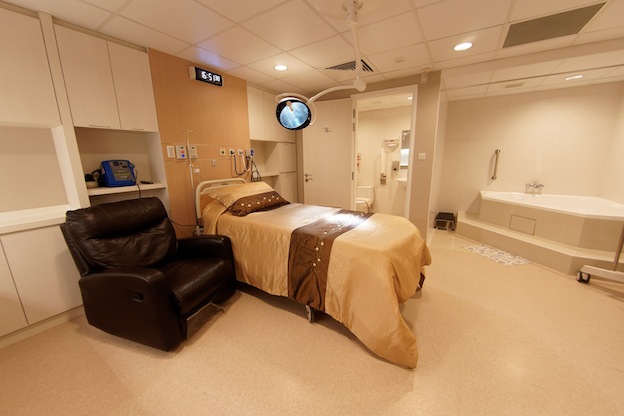
Should you be considering TMC for your baby’s birth, you’d be pleased to know that despite appearances, the hospital’s maternity rooms are generously sized. In fact, its standard 1-BD room seems to be sized around that of a suite in other hospitals!
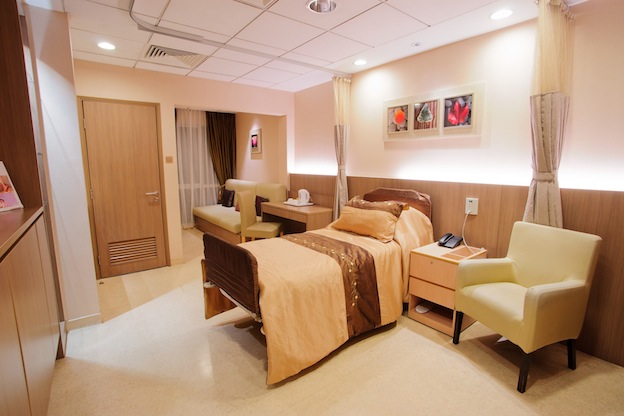
Each ward has individual temperature control. If you do not wish to be disturbed, you can even ask for a “Privacy Please” door tag.
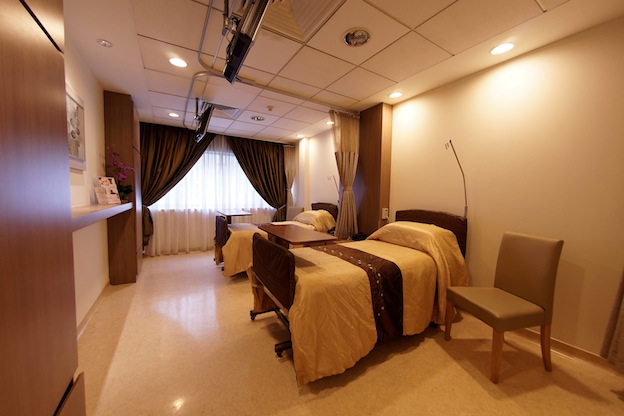
There are three floors of labour and maternity wards, Levels 3, 5 and 6, with a nursery attached to each. I find this a wonderful idea because Mummy and Baby won’t be too far apart! In addition, it’s easier for the nursing staff to manage as well.
TMC encourages rooming-in, so after Baby is tagged, he or she will be wheeled in with Mummy to bond. Overnight rooming-in of Baby is also allowed as long as it’s not too tiring on Mum. Does the same apply to shared wards? Yes, the hospital is flexible as long as your roommate doesn’t mind.
For the ultimate pampering experience, you could also opt to stay in one of the hospital’s suites. Do note that suites are not covered under maternity packages and will be billed ala carte. Here’s a quick look:
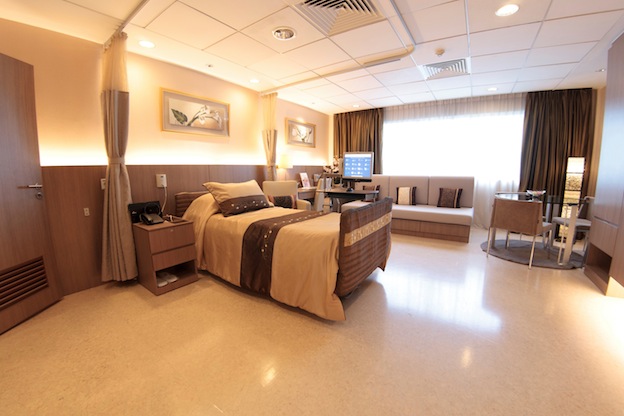
Chancery Suite.
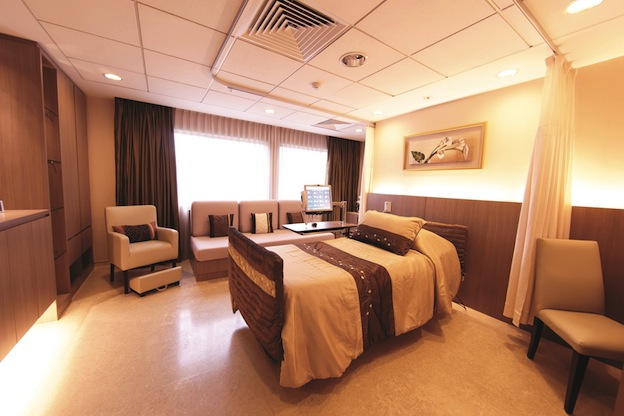
Newton Suite.
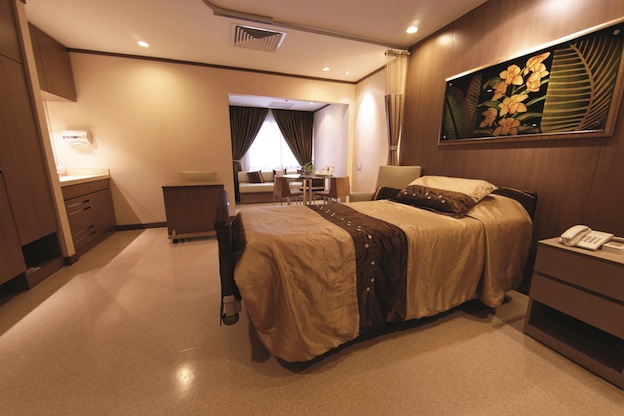
Premier Deluxe Suite.
Patients enjoy concessionary parking with the number of coupons issued based on bed type. Two coupons are issued to patients staying in 4-bedded rooms, and three coupons are issued to patients staying in Premier Single, Single, or 2-bedded rooms.
Food options include Delifrance and the staff cafeteria which is open from 9.30am to 5pm. You can also bus to Novena Square, or walk across the road for local food at Balestier and Whampoa.
Cost of tour: Free Cost of 1-BD normal delivery 2-day stay: $3,036.66 (excludes doctor’s fee)
National University Hospital
5 Lower Kent Ridge Rd, Singapore 119074. Tel: 6779 5555
As this hospital provides the only option for water birth (update: as of March 2024, the water births service is currently unavailable) in Singapore, NUH is my choice!
Each of its 12 delivery rooms is alternately equipped with water birth facilities in its ensuite bathrooms. Its deluxe delivery suite even comes with a built-in water tub. Exercise balls are also available on hand should Mummy require them for relaxation and pain relief. I like that the hospital has made the bathrooms spacious. After all, there will be a sizable medical team inside during the water birth: the doctor, the midwives and your doula , if you choose to have one.
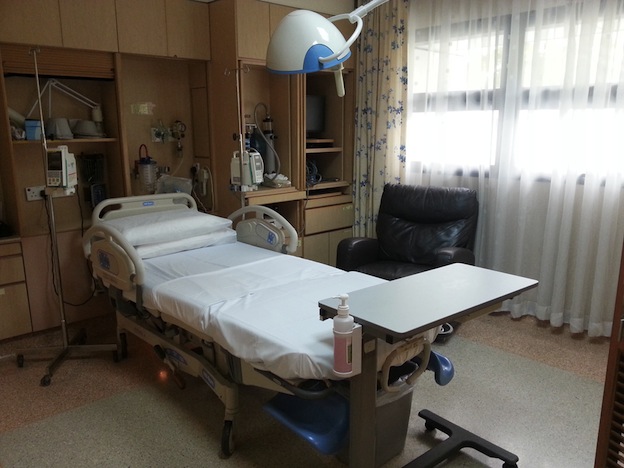
Deluxe delivery suite.
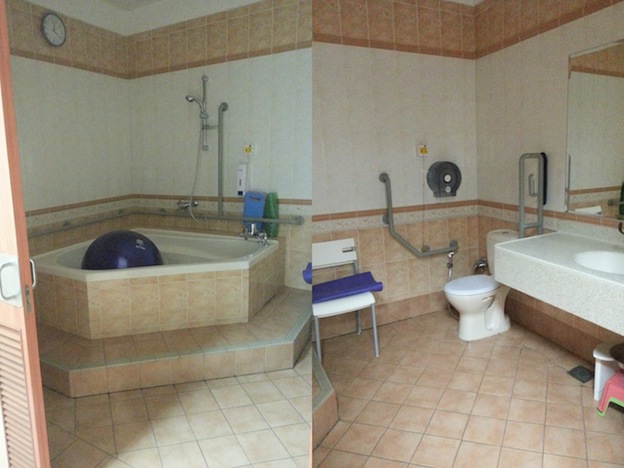
NUH’s deluxe delivery suite comes with a built-in water tub to facilitate water births.

While some other hospitals allow doulas in the delivery room as long as you pre-registration yours (most of them) and some do not allow doulas at all (Mt Elizabeth (Orchard), NUH not only allows doulas, the hospital also offers its own alternative: Emma Care nurses.
Emma Care Service at NUH
Short for Enhanced Midwifery Maternity Care, Emma Care nurses provide a unique holistic approach to childbirth and labour. Emma Care nurses accompany you on your journey during pregnancy and post delivery as well. That includes prenatal and postnatal clinic appointments, coaching your hubby to provide the support you need as a new mom, and nursing care and support during labour.
So your Emma Care nurse is more like a friend who also happens to be a trained nurse and midwife. Having somebody who understands your birth preferences and has the medical knowledge to back your decisions in the delivery room means a lot in terms of reassurance and emotional support. I like it!
For many mums (and dads), cost is not so much a concern as privacy and the option to lodge are. Hence the 1-BD rooms are often in high demand. NUH has 18 1-BD rooms. We hear that you have an 80 to 85% chance of getting one if you’ve requested for it during preregistration. Of course, there’s no guarantee, so please do not fume at the nurses if you don’t get one.
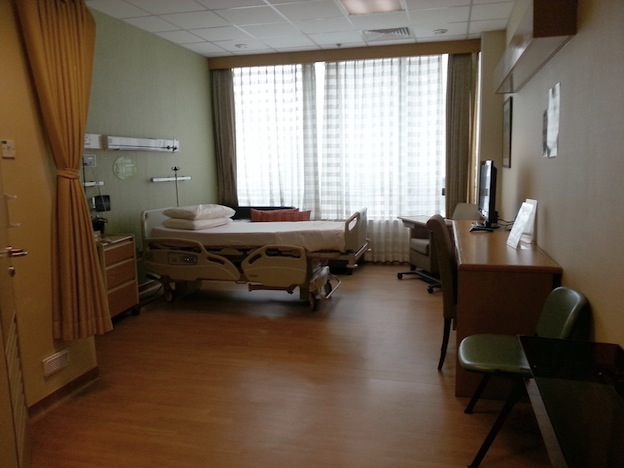
The 1-BD maternity room. Pretty spacious, don’t you think?
Each 1-BD room comes with a sofa bed, a TV set, a desk, and a couch for one person. Lodging is $37.45 (without meals) or $64.20 (with 3 meals) per day.
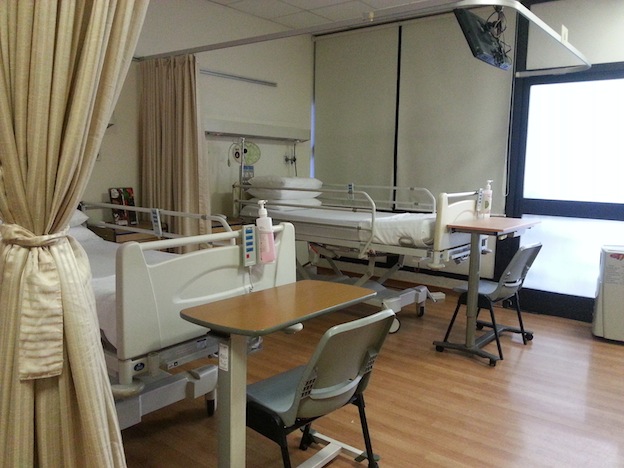
4-BD maternity room. Baby is allowed to room in with you at night in shared wards too.
Parking shouldn’t be a problem with 330 lots in Carpark D and 390 lots at the Medical Centre. The maximum rate is $18 for a full day of parking. If you are rushed to the hospital in mid-labour, the Dad-to-be can leave the car with the valet ($6 per entry).
There are plenty of amenities for visitors. These include food places, Duyi bookstore with a florist counter, and 7-Eleven.
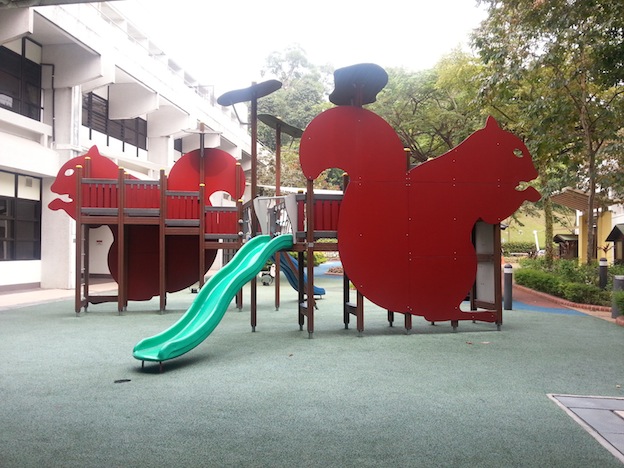
The squirrel playground outside the Children’s Clinic (Level 4) is a great place for the kids.
Cost of tour: Free Cost of 1-BD normal delivery 2-day stay: $3,110.50 to $4,608.50 (includes doctor’s fee)
See the rest of the hospital maternity tours here:
Gleneagles Hospital, KK Women’s and Children’s Hospital
Mt Alvernia Hospital, Mt Elizabeth (Orchard), Mt Elizabeth Novena Hospital
Parkway East Hospital, Raffles Hospital, Singapore General Hospital
Do note that these accounts are based on our writer’s personal experiences . D o get in touch with the hospital if you require further details about its maternity services or to attend maternity tours.
All costs and facts are accurate as of October 2015. GST and service charges not included.
All content from this article, including images, cannot be reproduced without credits or written permission from SingaporeMotherhood.
Follow us on Facebook , Instagram , and Telegram for the latest article and promotion updates.

Help Your Child Cope with Bullying

The Best Must-have Travel Essentials for Kids!
Share on: Facebook
Published on: 17 November 2015
Category: Parenting
Tagged in: hospital maternity tour , Review
Recommended Reading
Hospital maternity tours in singapore: gleneagles hospital & kk women’s and children’s hospital.
If you’re a first-time mum like me, you know how life-changing it can all be. Not only do you have to deal with debilitating pregnancy symptoms, which creep up on…
Hospital Maternity Tours in Singapore: Parkway East Hospital, Raffles Hospital, & Singapore General Hospital
Some parents like to choose when their Baby makes his or her entrance into the world. But all mums-to-be like to choose WHERE Baby will make his grand entrance. After…
Hospital Maternity Tours in Singapore: Mt Alvernia, Mt Elizabeth (Orchard), & Mt E Novena
Last week our (blissfully!) pregnant writer took you on hospital maternity tours though Gleneagles Hospital and KK Women’s and Children’s Hospital. This week, we’re bringing you through the rest of…
- Best Eat & Drink
- Best Entertainment
- Best Shopping
- Best Beauty
- Best Lifestyle
- Best Living
- Best Education
- Best Travel Guides
- Best Local Services
- Best Buying Guides
- Featured Businesses
- Questions & Answers
- Advertise With Us
- Best List Advertising

Thomson Medical Centre (TMC): Maternity service
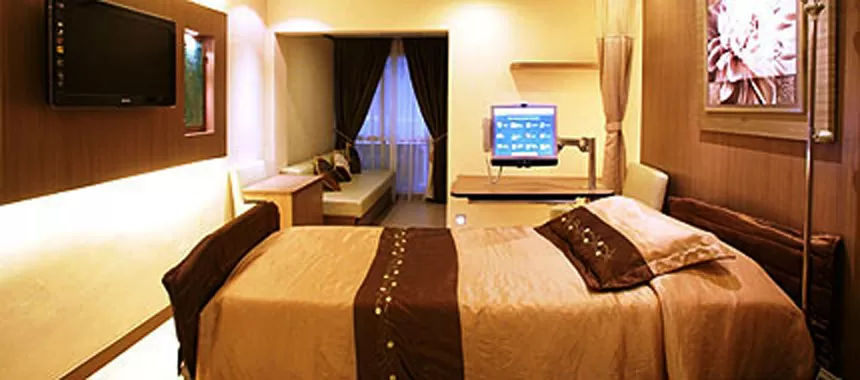
WHAT ARE SO SPECIAL? This hospital is one of the most affordable private hospitals for delivering a baby in Singapore , and one of the most popular.
TMC is carefully renovated to offer that ‘home-away-from-home’ environment for mums-to-be. Stay in a warmly lit, well-equipped room along with one companion, and lean a thing or two from the invaluable support services.
Listen up dads, there are classes here for you too! The Dad’s Enrichment Program will coach you to assist the mummy with the newborn.
QUICK FACTS:
- Only hospital in Singapore that offers home birth
- Complimentary ‘mummy pampering luggage’ including a kimono, slippers, overnight pads, and much more
- Confinement soup is cooked daily to provide you with a boost of nutrients
- Labour water-pool available
NORMAL DELIVERY COST:
- One-bed room: $5,954to $7,957
- Two-bed room: $4,639 to $6,558
- Four-bed room: $4,059 to $5812
MATERNITY TOUR:
- Tours are offered on Mondays and Fridays at 10:00 and 14:30, and on Saturdays at 10:00 and 12:00. Reserve your place by calling 6358 0055.
- Tour booking
SINGLE ROOM FACILITIES :
- En-suite facilities
- Flat-screen TV
- Living room in some suites
LOCATION : 339 Thomson Road, Singapore 307677
PHONE: (+65) 6250 2222
We recommend for you
Best hospitals to deliver baby.
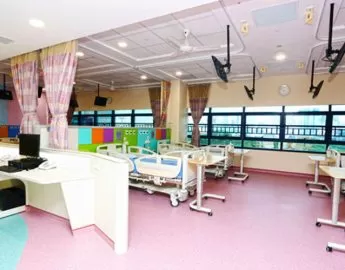
Most Popular

Eat & Drinks

Entertainment

University of Notre Dame
Rooney Center
- Home ›
- News ›
Swifties Band Together to Show Palestinian Solidarity at Taylor Swift’s Eras Tour
Published: June 26, 2024
Author: Chantelle Lee with Time
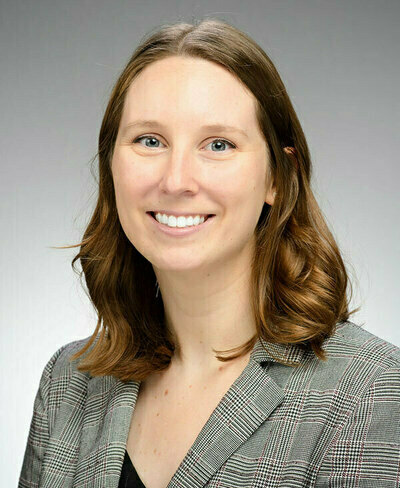
When Hadiyyah Mohamed brought out a Palestinian flag during the first Edinburgh show of Taylor Swift’s Eras Tour on June 7, she knew that it was unlikely the megastar would see it or her braided bracelet with the colors of the Palestinian flag—her seat was high up in a nosebleed section.
“No one saw except for the people that were really close around me,” Mohamed tells TIME. “It was my way of enjoying a Taylor Swift concert, as well as showing my support and my solidarity for the Palestinians.”
Last month, #SwiftiesForPalestine was trending on X, garnering more than 100,000 posts in about a day, as Swifties used the hashtag to demand that Taylor Swift “Speak Now” on Gaza. The online callout came after an Israeli airstrike in Rafah that killed at least 45 Palestinians sparked outrage around the world.
Some celebrities, such as Ariana Grande, have shared social media posts in support of Palestinian people. Others have been even more vocal in their show of solidarity—Melissa Barrera was fired from her leading role in Scream 7, after she posted in support of Palestinian people; and Kehlani called out their peers in the music industry for remaining silent on the conflict and raised more than $555,000 for families in Gaza, Sudan, and the Democratic Republic of Congo. Macklemore demanded a cease-fire in his song, “Hind’s Hall,” a reference to when protesters took over Hamilton Hall at Columbia University and “renamed” the building for 6-year-old Hind Rajab, who was killed by Israeli troops. But Swift has not publicly spoken out on the conflict.
Now, Swifties have taken the online movement to the international leg of the singer’s Eras Tour. The international leg of the tour started in August 2023, but only recently have fans gained attention for bringing Palestinian flags, kaffiyehs, signs, or friendship bracelets—an Eras Tour tradition—to express support for Palestinians. While Swifties initially wanted to bring these symbols to pressure Swift to speak out in support of Palestinian people—and while many still hope she will—fans also said they were inspired to participate in the trend to raise awareness among other Swifties and concertgoers about the situation in Gaza.
Calling on Swift to “Speak Now”
Earlier on in her career, Swift was known for not posting online or speaking publicly about politics. But in 2018, she broke that silence and endorsed two Democratic candidates in Tennessee. Since then, she endorsed President Joe Biden in the 2020 election and has expressed support for abortion and LGBTQ+ rights. In 2023, after Swift encouraged fans to register to vote via a post on her Instagram story, Vote.org recorded more than 35,000 registrations.
“We can see that her impact is so powerful,” Swiftie Keli Thomson, who lives in Glasgow, says. “It is a shame that she’s not used that platform. I am hoping that she will eventually come around to it.”
Mohamed, 22, has been a Swiftie for as long as she can remember. But now, the lifelong fan criticizes Swift for not speaking out, saying “silence is violence.”
“I am disappointed in Taylor Swift,” Mohamed, who lives in Edinburgh, says. “I still do love Taylor Swift songs and I really do think she’s an amazing artist. But at this point, we need her to speak now. We need her to speak up.”
Swift’s publicist did not return a request for comment.
After Thomson, 30, saw #SwiftiesForPalestine trending on X, she encouraged other fans who were planning to attend the shows in Edinburgh, like she was, to make friendship bracelets and bring Palestinian flags. She wasn’t sure that bringing these items would prompt Swift to speak out, but thought that “it would be a wasted opportunity not to try.”
Thomson went to two shows in Edinburgh earlier this month. On the first night, she was a little disheartened—while she had brought a Palestinian flag, she was too far back from the stage for Swift to see her and ended up just hanging the flag on the back of her chair for most of the night.
“I think the reality of it kicked in when I was there,” Thomson says. “It is obviously much bigger when you get in there and see the amount of people that are there and realize for this to be impactful, we really do need to get more people involved.”
“We weren’t the only ones”
There was a moment that made Thomson hopeful. She had made some friendship bracelets for the concert. Friendship bracelets are an Eras Tour tradition—because Swift mentions “friendship bracelets” in the song “You’re on Your Own, Kid,” fans often show up to her concerts wearing and exchanging bracelets that have references to Swift’s songs.
Thomson had made a few special bracelets—two that said “Free Palestine,” and one that said “Eyes On Rafah.” While waiting in line for food at the concert, she gave one of the “Free Palestine'' bracelets to another Swiftie. The two fans ended up having a “really hopeful conversation” about the conflict in Gaza, Thomson says.
For 24-year-old Jemima Elliott, exchanging a bracelet didn’t lead to a conversation, but it still made her night. Elliott, who lives in Newcastle, England, attended the second night of the Eras Tour show in Edinburgh earlier this month, and wore a “Free Palestine” badge on her jacket. She had also made small cardboard signs that said “Swifties 4 A Free Palestine” and “Speak Now For a Free Palestine.”
“It’s really frustrating when there’s someone whose work you really admire and you really love, who kind of has that huge, astronomic level of influence, but doesn’t use that to stand out for things,” Elliott says. Bringing in the signs and wearing the badge “felt like the bare minimum” she could do, she adds.
Another fan noticed Elliott’s “Free Palestine” badge and then gave her a friendship bracelet that said “Speak Now for Gaza.”
“Receiving that friendship bracelet made my absolute night,” Elliott says. “It felt like we weren’t the only ones who were thinking about Gaza, who were wanting Taylor to do better.”
One Swiftie managed to give one of these special friendship bracelets to Swift’s current number one fan: her boyfriend, Super Bowl-winning Kansas City Chiefs tight end Travis Kelce.
Alethea Shapiro, who lives in Naples, Fla., was at the first London show Friday when she saw Kelce in Wembley Stadium. Shapiro weaved through the crowd to pass a “Swifties For Palestine” bracelet along to the star athlete.
“I really had to seize the moment because it was like the closest we got to Taylor and him, like both of them have very big platforms,” Shapiro, 45, says. “Maybe he passed it along to Taylor.”
Kelce’s publicist did not return a request for comment.
Shapiro went to several Eras Tour shows in the U.S., has been to a show in Lyon, France, and multiple shows in the U.K., including Edinburgh, Liverpool, Cardiff, and London. She started an Instagram account, called @SwiftiesForPalestine, that has about 3,700 followers and shares information about the conflict in Gaza. For many of the shows she’s attended in Europe, she’s brought something—like a flag, a kaffiyeh, or an outfit that includes references to the conflict—to show solidarity with Palestinian people.

“This is the start of something”
It’s not clear when the #SwiftiesForPalestine movement began or who started it—while Swifties have only recently gained attention for it on the European leg of the Eras Tour, a post on X from earlier this year indicates that some Swifties were planning to make friendship bracelets in support of Palestinian people starting with the Melbourne show back in February.
One thing is clear, though: Fans plan to continue doing this for Swift’s upcoming shows.
Shapiro is hoping to attend some of the final London shows in August, and has tickets for shows in Miami and Vancouver in the fall. She hopes that Swifties will continue voicing their support for Palestinian people at each concert.
“If Taylor’s not going to do it, then we can still do something,” Shapiro says. “We can still speak out. And I just think it’s really beautiful that people who are around the world, all different nationalities and races and languages, sexualities, can come together and unify for Palestine.”
Thomson is also planning to go to the last London show in August. And this time, she’s planning on making even more friendship bracelets that express support for Palestinian people.
“It just needs to grow. It just needs a little bit more time,” she says about the movement. “I think this is the start of something.”
Does Swiftie activism bring about change?
This isn’t the first time the Swiftie fandom has galvanized around a political cause. In 2022, thousands of fans banded together to launch an online campaign calling for the breakup of Ticketmaster, after many of them were unable to get tickets to the U.S. leg of the Eras Tour.
After the Ticketmaster fiasco, two political science researchers at the University of Notre Dame started researching Swifties, and found that fans who had a personal experience with the issue of a lack of market competition tended to file reports with the Federal Trade Commission at higher rates. Erin Rossiter, one of the researchers, says that while it’s not clear the extent to which Swifties’ complaints led to the U.S. Department of Justice suing Ticketmaster and its parent company, she and her colleague “like to think and speculate” that this grassroots effort among Swifties “shed light on this issue.”
Their research, which they’re in the process of submitting for peer review, offers some “cautiously optimistic evidence” that people become engaged and take action on political issues that they care about, Rossiter says.
Now, the public is seeing a similar kind of political activism among Swifties with regards to the conflict in Gaza, Rossiter says. While there may be division within the Swiftie community, the fandom is often “interconnected” and “coordinated,” she says.
“This can lend them to be politically motivated as well. They’re very willing to use their time and resources to solve a problem, which is like what we felt with Ticketmaster,” Rossiter says. “This group has a history, and they know how to work together in this way and they’re very good at it.”
And others have noticed this. Volunteers with the Edinburgh Gaza Genocide Emergency Committee (EGGEC)—a coalition of organizations that stand in solidarity with Palestinian people—handed out flyers, friendship bracelets, and Palestinian flags outside of the concert venue in Edinburgh on June 8 to raise awareness among fans heading into the show.
“I think if her fans mobilize and if her fans use their big voices—a lot of them have big social media platforms—if they can use that to raise awareness, then you can mobilize a huge crowd of people and bring awareness into the music industry and into those spaces,” says Ameerah Al, an EGGEC volunteer who handed out flyers and flags on June 8.
When #SwiftiesForPalestine was trending on X, one fan started a GoFundMe, raising nearly $14,000 CAD to go toward Medical Aid for Palestinians, a British organization that offers medical services to those in need. One Swiftie who attended two London shows this past weekend donated the money she would’ve spent on merchandise to Care For Gaza, a nonprofit that helps Palestinian families.
Rossiter points out that Swift herself has not been the leader of these movements—both the action against Ticketmaster and the solidarity campaign for Palestinian people have been fan-led initiatives.
“It doesn’t lessen the disappointment among the fans when she doesn’t say anything, but they are still a very motivated group without her,” Rossiter says.
While Mohamed hopes that Swift will speak out publicly in support of Palestinian people, she isn’t sure that will really happen. On the off chance Swift saw Mohamed waving the flag at the first show in Edinburgh, Mohamed says she “would feel heard.”
“That’s the point, really, for me to wave that flag,” she says. “And it’s not only me—for Palestine to feel heard because for years, it’s been 76 years, their yearnings, their pleas, have been gone unheard of.”
- Entertainment
- celebrities
Swifties Band Together to Show Palestinian Solidarity at Taylor Swift’s Eras Tour

W hen Hadiyyah Mohamed brought out a Palestinian flag during the first Edinburgh show of Taylor Swift’s Eras Tour on June 7, she knew that it was unlikely the megastar would see it or her braided bracelet with the colors of the Palestinian flag—her seat was high up in a nosebleed section.
“No one saw except for the people that were really close around me,” Mohamed tells TIME. “It was my way of enjoying a Taylor Swift concert, as well as showing my support and my solidarity for the Palestinians.”
Last month, #SwiftiesForPalestine was trending on X, garnering more than 100,000 posts in about a day, as Swifties used the hashtag to demand that Taylor Swift “Speak Now” on Gaza. The online callout came after an Israeli airstrike in Rafah that killed at least 45 Palestinians sparked outrage around the world.
Some celebrities, such as Ariana Grande , have shared social media posts in support of Palestinian people. Others have been even more vocal in their show of solidarity— Melissa Barrera was fired from her leading role in Scream 7, after she posted in support of Palestinian people; and Kehlani called out their peers in the music industry for remaining silent on the conflict and raised more than $555,000 for families in Gaza, Sudan, and the Democratic Republic of Congo. Macklemore demanded a cease-fire in his song, “Hind’s Hall,” a reference to when protesters took over Hamilton Hall at Columbia University and “renamed” the building for 6-year-old Hind Rajab, who was killed by Israeli troops. But Swift has not publicly spoken out on the conflict.
Read More: Calls to Boycott Celebrities for Silence on the War in Gaza Spark a Debate Over Online Activism
Now, Swifties have taken the online movement to the international leg of the singer’s Eras Tour. The international leg of the tour started in August 2023 , but only recently have fans gained attention for bringing Palestinian flags, kaffiyehs, signs, or friendship bracelets—an Eras Tour tradition—to express support for Palestinians. While Swifties initially wanted to bring these symbols to pressure Swift to speak out in support of Palestinian people—and while many still hope she will—fans also said they were inspired to participate in the trend to raise awareness among other Swifties and concertgoers about the situation in Gaza.
Calling on Swift to “Speak Now”
Earlier on in her career, Swift was known for not posting online or speaking publicly about politics. But in 2018, she broke that silence and endorsed two Democratic candidates in Tennessee. Since then, she endorsed President Joe Biden in the 2020 election and has expressed support for abortion and LGBTQ+ rights. In 2023, after Swift encouraged fans to register to vote via a post on her Instagram story, Vote.org recorded more than 35,000 registrations .
“We can see that her impact is so powerful,” Swiftie Keli Thomson, who lives in Glasgow, says. “It is a shame that she’s not used that platform. I am hoping that she will eventually come around to it.”
Mohamed, 22, has been a Swiftie for as long as she can remember. But now, the lifelong fan criticizes Swift for not speaking out, saying “silence is violence.”
“I am disappointed in Taylor Swift,” Mohamed, who lives in Edinburgh, says. “I still do love Taylor Swift songs and I really do think she’s an amazing artist. But at this point, we need her to speak now. We need her to speak up.”
Swift’s publicist did not return a request for comment.
After Thomson, 30, saw #SwiftiesForPalestine trending on X, she encouraged other fans who were planning to attend the shows in Edinburgh, like she was, to make friendship bracelets and bring Palestinian flags. She wasn’t sure that bringing these items would prompt Swift to speak out, but thought that “it would be a wasted opportunity not to try.”
EDINBURGH SWIFTIES! I think we have a chance to make a statement. Make Palestine bracelets, bring Palestine flags, front rows take signs!! The impact Taylor could have is insane, and we cannot let it slide. Spread this far and wide - tell your pals going!! #SwiftiesForPalestine pic.twitter.com/I4vUqdcuBY — keli {bandea}🌻 (@iambandea) May 29, 2024
Thomson went to two shows in Edinburgh earlier this month. On the first night, she was a little disheartened—while she had brought a Palestinian flag, she was too far back from the stage for Swift to see her and ended up just hanging the flag on the back of her chair for most of the night.
“I think the reality of it kicked in when I was there,” Thomson says. “It is obviously much bigger when you get in there and see the amount of people that are there and realize for this to be impactful, we really do need to get more people involved.”
“We weren’t the only ones”
There was a moment that made Thomson hopeful. She had made some friendship bracelets for the concert. Friendship bracelets are an Eras Tour tradition—because Swift mentions “friendship bracelets” in the song “You’re on Your Own, Kid,” fans often show up to her concerts wearing and exchanging bracelets that have references to Swift’s songs.
Thomson had made a few special bracelets—two that said “Free Palestine,” and one that said “Eyes On Rafah.” While waiting in line for food at the concert, she gave one of the “Free Palestine'' bracelets to another Swiftie. The two fans ended up having a “really hopeful conversation” about the conflict in Gaza, Thomson says.

For 24-year-old Jemima Elliott, exchanging a bracelet didn’t lead to a conversation, but it still made her night. Elliott, who lives in Newcastle, England, attended the second night of the Eras Tour show in Edinburgh earlier this month, and wore a “Free Palestine” badge on her jacket. She had also made small cardboard signs that said “Swifties 4 A Free Palestine” and “Speak Now For a Free Palestine.”
“It’s really frustrating when there’s someone whose work you really admire and you really love, who kind of has that huge, astronomic level of influence, but doesn’t use that to stand out for things,” Elliott says. Bringing in the signs and wearing the badge “felt like the bare minimum” she could do, she adds.
Another fan noticed Elliott’s “Free Palestine” badge and then gave her a friendship bracelet that said “Speak Now for Gaza.”
“Receiving that friendship bracelet made my absolute night,” Elliott says. “It felt like we weren’t the only ones who were thinking about Gaza, who were wanting Taylor to do better.”
The best friendship bracelet I could have been given 💜🇵🇸 #FreePalestine #SwiftiesForPalestine pic.twitter.com/da0sleAasM — Jemima 🍉 #StopRosebank (she/her) (@arantingreader) June 10, 2024
One Swiftie managed to give one of these special friendship bracelets to Swift’s current number one fan: her boyfriend, Super Bowl-winning Kansas City Chiefs tight end Travis Kelce .
Alethea Shapiro, who lives in Naples, Fla., was at the first London show Friday when she saw Kelce in Wembley Stadium. Shapiro weaved through the crowd to pass a “Swifties For Palestine” bracelet along to the star athlete.
“I really had to seize the moment because it was like the closest we got to Taylor and him, like both of them have very big platforms,” Shapiro, 45, says. “Maybe he passed it along to Taylor.”
Kelce’s publicist did not return a request for comment.
Shapiro went to several Eras Tour shows in the U.S., has been to a show in Lyon, France, and multiple shows in the U.K., including Edinburgh, Liverpool, Cardiff, and London. She started an Instagram account, called @SwiftiesForPalestine , that has about 3,700 followers and shares information about the conflict in Gaza. For many of the shows she’s attended in Europe, she’s brought something—like a flag, a kaffiyeh, or an outfit that includes references to the conflict—to show solidarity with Palestinian people.
Palestine FLAG DROP completed ☑️ 🇵🇸🍉 I hope this gets this keeps the conversation and focus on @taylorswift & Swifties around the world to #speaknow about PALESTINE!!! 🇵🇸✊🏽🍉🎵❤️🩹💔 JOIN OUR GLOBAL MOVEMENT on Instagram @swiftiesforpalestine 🇵🇸🫶 #FLAGDROP #SwiftiesforPalestine … pic.twitter.com/XFlS7c4vGI — Alethea⸆⸉ @swiftiesforpalestine Insta official (@Women2Dc) June 3, 2024
“This is the start of something”
It’s not clear when the #SwiftiesForPalestine movement began or who started it—while Swifties have only recently gained attention for it on the European leg of the Eras Tour, a post on X from earlier this year indicates that some Swifties were planning to make friendship bracelets in support of Palestinian people starting with the Melbourne show back in February.
thats me!! #LisbonTStheErasTour #TSTheErasTour https://t.co/0In0Je92mb pic.twitter.com/0oIPC9OvsM — sofia🍉 (@faeriee_soiree) May 25, 2024
One thing is clear, though: Fans plan to continue doing this for Swift’s upcoming shows.
Shapiro is hoping to attend some of the final London shows in August, and has tickets for shows in Miami and Vancouver in the fall. She hopes that Swifties will continue voicing their support for Palestinian people at each concert.
“If Taylor’s not going to do it, then we can still do something,” Shapiro says. “We can still speak out. And I just think it’s really beautiful that people who are around the world, all different nationalities and races and languages, sexualities, can come together and unify for Palestine.”
Thomson is also planning to go to the last London show in August. And this time, she’s planning on making even more friendship bracelets that express support for Palestinian people.
“It just needs to grow. It just needs a little bit more time,” she says about the movement. “I think this is the start of something.”
i think my fave thing abt liverpool eras n1 was being sat directly behind someone who was showing their support for palestine head to toe, they waved a palestine flag, i gave them one of the free palestine bracelets we’d made & they gave us free palestine bands in return 🇵🇸🍉 pic.twitter.com/Yf48Fg49Kd — sahi | milfsincrime 🌸🍉 (@badboybelzer) June 16, 2024
Does Swiftie activism bring about change?
This isn’t the first time the Swiftie fandom has galvanized around a political cause. In 2022, thousands of fans banded together to launch an online campaign calling for the breakup of Ticketmaster, after many of them were unable to get tickets to the U.S. leg of the Eras Tour.
After the Ticketmaster fiasco, two political science researchers at the University of Notre Dame started researching Swifties, and found that fans who had a personal experience with the issue of a lack of market competition tended to file reports with the Federal Trade Commission at higher rates. Erin Rossiter, one of the researchers, says that while it’s not clear the extent to which Swifties’ complaints led to the U.S. Department of Justice suing Ticketmaster and its parent company, she and her colleague “like to think and speculate” that this grassroots effort among Swifties “shed light on this issue.”
Their research, which they’re in the process of submitting for peer review, offers some “cautiously optimistic evidence” that people become engaged and take action on political issues that they care about, Rossiter says.
Now, the public is seeing a similar kind of political activism among Swifties with regards to the conflict in Gaza, Rossiter says. While there may be division within the Swiftie community, the fandom is often “interconnected” and “coordinated,” she says.
“This can lend them to be politically motivated as well. They’re very willing to use their time and resources to solve a problem, which is like what we felt with Ticketmaster,” Rossiter says. “This group has a history, and they know how to work together in this way and they’re very good at it.”
And others have noticed this. Volunteers with the Edinburgh Gaza Genocide Emergency Committee (EGGEC)—a coalition of organizations that stand in solidarity with Palestinian people—handed out flyers, friendship bracelets, and Palestinian flags outside of the concert venue in Edinburgh on June 8 to raise awareness among fans heading into the show.
“I think if her fans mobilize and if her fans use their big voices—a lot of them have big social media platforms—if they can use that to raise awareness, then you can mobilize a huge crowd of people and bring awareness into the music industry and into those spaces,” says Ameerah Al, an EGGEC volunteer who handed out flyers and flags on June 8.
#swiftiesforpalastine #LyonTSTheErasTour pic.twitter.com/BY9xExPW6b — monica (@monikeramirez) June 3, 2024
When #SwiftiesForPalestine was trending on X, one fan started a GoFundMe , raising nearly $14,000 CAD to go toward Medical Aid for Palestinians , a British organization that offers medical services to those in need. One Swiftie who attended two London shows this past weekend donated the money she would’ve spent on merchandise to Care For Gaza , a nonprofit that helps Palestinian families.
Rossiter points out that Swift herself has not been the leader of these movements—both the action against Ticketmaster and the solidarity campaign for Palestinian people have been fan-led initiatives.
“It doesn’t lessen the disappointment among the fans when she doesn’t say anything, but they are still a very motivated group without her,” Rossiter says.
While Mohamed hopes that Swift will speak out publicly in support of Palestinian people, she isn’t sure that will really happen. On the off chance Swift saw Mohamed waving the flag at the first show in Edinburgh, Mohamed says she “would feel heard.”
“That’s the point, really, for me to wave that flag,” she says. “And it’s not only me—for Palestine to feel heard because for years, it’s been 76 years , their yearnings, their pleas, have been gone unheard of.”
More From TIME
More must-reads from time.
- Melinda French Gates Is Going It Alone
- How to Buy Groceries Without Breaking the Bank
- Lai Ching-te Is Standing His Ground
- What’s the Best Pillow Setup for Sleep?
- How Improv Comedy Can Help Resolve Conflicts
- 4 Signs Your Body Needs a Break
- The 15 Best Movies to Watch on a Plane
- Want Weekly Recs on What to Watch, Read, and More? Sign Up for Worth Your Time
Contact us at [email protected]
‘This is definitely my home.’ Wellesley’s Michael Thorbjornsen makes his PGA Tour pro debut in his own backyard.

When Michael Thorbjornsen took his first tee shot at Wellesley High School’s boys’ golf tryouts, coach Ken Bateman saw his talent.
“The first thing I remember is thinking to myself, ‘I’ve never seen a high school golfer like this,’ ” Bateman said.
Bateman knew what he saw that day, but he had no way of knowing just how long his shock would continue.
On Thursday, the 22-year-old Thorbjornsen will make his professional debut as a PGA Tour member at the 2024 Travelers Championship at TPC River Highlands in Cromwell, Conn. It’s the same course where he made his first start in a PGA Tour event as an amateur in 2022 and finished fourth .
Thorbjornsen, who won the 2018 US Junior Amateur and played at Stanford, earned his tour card after finishing the PGA Tour University season ranked No. 1.
Advertisement
“This is definitely my home, I would say, on the PGA Tour,” Thorbjornsen said Wednesday afternoon. “I couldn’t ask for a better start.”
He will tee off at 2 p.m. Thursday and 10:50 a.m. Friday for the first two rounds, and shares these times with last year’s PGA Tour University champion Ludvig Åberg.
Åberg has been one of the top newcomers on the PGA Tour this season, including a second-place finish at the Masters and a 12th-place finish at the US Open, which he led after two rounds .
Michael Thorbjornsen is making his pro debut at the Travelers. Like Åberg last year, Thorbjornsen immediately projects as a top driver on TOUR. As an am, he finished fourth at this event in 2022. His stats there: SG: Off the Tee — +3.44, sixth Driving distance — 310.4, sixth pic.twitter.com/atsOVPbXz3 — Paul Hodowanic (@PaulHodowanic) June 19, 2024
Thorbjornsen said he spoke with Åberg Tuesday, and the pair text occasionally. He knows a bit about the transition from amateur to professional from both peers and experience with rigorous schedules, so Thorbjornsen isn’t overly worried.
“I’m going to do my best that I possibly can, and, I mean, this is just the start, so hopefully I keep getting better at managing everything,” Thorbjornsen said.
The Travelers Championship, which was elevated to a PGA Tour Signature Event this season, runs Thursday through Sunday. Keegan Bradley, who also played high school golf in Massachusetts at Hopkinton High, is the defending champion .
Thorbjornsen spent his first three years of high school at IMG Academy in Bradenton, Fla., and when he transferred to Wellesley High, he had already committed to Stanford. He graduated from Stanford this spring while finishing the college golf season with a 1334.7862 point average to earn his PGA Tour card.
Putting life in perspective. Making his professional debut this week @TravelersChamp , Michael Thorbjornsen talks about how an injury last season made him appreciate his time @StanfordMGolf and his golf career. pic.twitter.com/0rkUzdPEeF — PGA TOUR University (@PGATOURU) June 19, 2024
Thorbjornsen said part of his reason for transferring to Wellesley High in 2019 was needing a break because of the rigor of IMG and what was to come at Stanford.
“It was good to kind of reignite some friendships,” he added. “Playing on the golf team was a lot of fun. Didn’t know golf could be that much fun at times, even if you don’t play too well. Worked on my game a little bit here and there, but also kind of relaxed and prepared for the next four years at college.”
Bateman knew his role as Thorbjornsen’s coach at Wellesley wasn’t to improve his game.
“I just wanted him to have a normal season,” Bateman said. “I wanted him to be with his friends. I wanted him to enjoy the experience, because it was his only year at Wellesley High. That was the thing that kept going through my head.”
Welcoming 2024 PGA TOUR University winner Michael Thorbjornsen to the field on a sponsor’s exemption! He’s back in his native New England for his third straight Travelers Championship … this time making his professional debut. pic.twitter.com/bRjkomamBm — TravelersChamp (@TravelersChamp) June 10, 2024
Thorbjornsen’s father, Ted, who is also his coach, will be with him in Connecticut, as well as his mother, Sandra, and a couple of high school friends are coming to support his start. It’s a home debut through and through, and Thorbjornsen will have home with him on the green in his caddie and longtime friend Drew Cohen. The pair have been friends since middle school and reunited on the course at Wellesley. Cohen has caddied for Thorbjornsen since 2021, including two US Opens .
While they were in town for the 2022 US Open in Brookline, they stopped in to see their old coach, who’s been following their careers since they left.
“I just love watching it,” Bateman said. “I love watching them both.”
When he saw Thorbjornsen on the Travelers Championship website under ‘notable golfers,’ Bateman’s mind was blown, and he quickly texted Cohen to ask if he’d be on the bag.
“I was thinking it was so awesome to see this kid who was destined for all these great things, to see him be a normal high school kid,” Bateman recalled. “That is the vision that I’m going to remember him just being a kid. But the way Michael’s played in a handful of tournaments over the last few years, the PGA ones, especially, it’s been fantastic to watch.”
Sarah Barber can be reached at [email protected] .
- Who are the Volga Germans?
- Settlements along the Volga
Mapping information provided by Sandy Payne germansfromrussiasettlementlocations.org
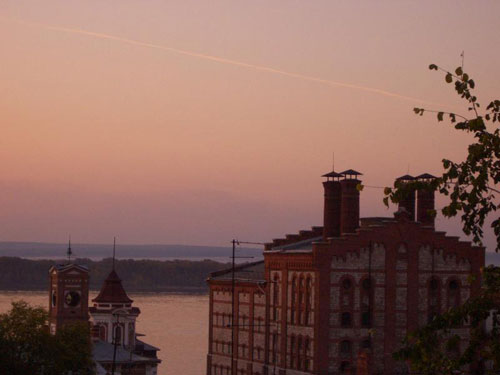
An independent Lutheran parish was established in Samara in 1904.
The Lutheran parish in Samara was served by the following pastors:
Eduard Heinrich Johannson, vicar (1868-1870) Eduard Gahlnbäck, vicar (1870-1878) Friedrich Wilhelm Meyer, vicar (1879-1903) Woldemar Baron Engelhardt (1903-1910) Ewald Allas, Vicar (1910-1915) Hermann Lezius (1913-1915) Nikolai Tomberg (1916-1917) Hermann Lezius (1917-1922)
Samara was founded between 1586 and 1591 for the purpose of protecting the Russian frontier against the Bashkirs, the Kalmucks and the Nogai Tatars. Samara is located on the left bank of the Volga River, 305 miles S.S.E. of Kazan. It is the capital of the Samara Province. Its population was 63,479 in 1883 and 91,672 in 1897. The Siberian and Central Asian railways meet in Samara. As of 1911, it a commercial depot for cereals and a center for flour-milling. In 1911, the city gave title to a bishop of the Orthodox Greek Church and had three cathedrals built in 1685, 1730-1735, and 1894 respectively. There were three public libraries and a natural history and archaeological museum. It is famous for its kumis (mare's milk) cures.
Samara was known by the name Kuybyshev from 1935 to 1990. It is the administrative capital of the Samara Oblast.
Amburger, Erik. Die Pastoren der evangelischen Kirchen Rußlands (Lüneburg, Germany: Institut Nordostdeutsches Kulturwerk, 1998): 139-140.
Encyclopaedia Britannica , 1911.
Schnurr, Joseph. Die Kirchen und das religiöse Leben der Russlanddeutschen – Evangelischer Teil (Stuttgart: AER Verlag Landsmannschaft der Deutschen aus Rußland, 1978): 351.
Samara, Russia (Wikipedia)
Geographic card depicting the key feature of Samara Province (1856) (World Digital Library)
An official website of the United States government
The .gov means it’s official. Federal government websites often end in .gov or .mil. Before sharing sensitive information, make sure you’re on a federal government site.
The site is secure. The https:// ensures that you are connecting to the official website and that any information you provide is encrypted and transmitted securely.
- Publications
- Account settings
Preview improvements coming to the PMC website in October 2024. Learn More or Try it out now .
- Advanced Search
- Journal List
- v.7(1); 2006

The Directly Observed Therapy Short-Course (DOTS) strategy in Samara Oblast, Russian Federation
Y balabanova.
1 HPA Mycobacterium Reference Unit, Clinical TB and HIV Group, St Bartholomew and Queen Mary School of Medicine, 2 Newark street, London E1 2AT, UK
3 Samara City Tuberculosis Dispensary N1, Pionerskaya street, Samara, 443001, Russia
F Drobniewski
2 Samara Oblast Tuberculosis Dispensary, Samara, 154 Novo-Sadovaya Street, 443068, Russia
S Zakharova
V nikolayevskyy.
4 Center for Health Management, Tanaka Business School, Imperial College London, South Kensington campus, London SW7 2AZ, UK
5 Department of Public Health and Policy, London School of Hygiene and Tropical Medicine, Keppel Street, London WC1E 7HT, UK
This is an Open Access article distributed under the terms of the Creative Commons Attribution License ( http://creativecommons.org/licenses/by/2.0 ), which permits unrestricted use, distribution, and reproduction in any medium, provided the original work is properly cited.
The World Health Organisation (WHO) defines Russia as one of the 22 highest-burden countries for tuberculosis (TB). The WHO Directly Observed Treatment Short Course (DOTS) strategy employing a standardised treatment for 6 months produces the highest cure rates for drug sensitive TB. The Russian TB service traditionally employed individualised treatment.
The purpose of this study was to implement a DOTS programme in the civilian and prison sectors of Samara Region of Russia, describe the clinical features and outcomes of recruited patients, determine the proportion of individuals in the cohorts who were infected with drug resistant TB, the degree to which resistance was attributed to the Beijing TB strain family and establish risk factors for drug resistance.
prospective study
2,099 patients were recruited overall. Treatment outcomes were analysed for patients recruited up to the third quarter of 2003 (n = 920). 75.3% of patients were successfully treated. Unsuccessful outcomes occurred in 7.3% of cases; 3.6% of patients died during treatment, with a significantly higher proportion of smear-positive cases dying compared to smear-negative cases. 14.0% were lost and transferred out. A high proportion of new cases (948 sequential culture-proven TB cases) had tuberculosis that was resistant to first-line drugs; (24.9% isoniazid resistant; 20.3% rifampicin resistant; 17.3% multidrug resistant tuberculosis). Molecular epidemiological analysis demonstrated that half of all isolated strains (50.7%; 375/740) belonged to the Beijing family. Drug resistance including MDR TB was strongly associated with infection with the Beijing strain (for MDR TB, 35.2% in Beijing strains versus 9.5% in non-Beijing strains, OR-5.2. Risk factors for multidrug resistant tuberculosis were: being a prisoner (OR 4.4), having a relapse of tuberculosis (OR 3.5), being infected with a Beijing family TB strain (OR 6.5) and having an unsuccessful outcome from treatment (OR 5.0).
The implementation of DOTS in Samara, Russia, was feasible and successful. Drug resistant tuberculosis rates in new cases were high and challenge successful outcomes from a conventional DOTS programme alone.
Since the 1990s the World Health Organization Directly Observed Therapy Short Course (DOTS) management strategy has become the internationally recommended approach for tuberculosis (TB) control programmes [ 1 - 3 ]. By the beginning of the new Millennium, 149 countries in the world had adopted the DOTS strategy to varying degrees and important measures of DOTS success (case detection and treatment success) were included in the Millennium Development Goals framework [ 4 ]. In the former Soviet Union (FSU) only a limited number of WHO DOTS implementation programmes exist and currently countries of the FSU report the lowest case detection rates (22%) with 9% of cases failing treatment and a death rate of 7% during treatment [ 4 ]. WHO has acknowledged that until TB is controlled in Africa and Eastern Europe, this disease will remain of major world-wide concern; current analysis indicates that it is unlikely that the Millennium Development Targets for TB will be met in these regions [ 4 ].
Russia is one of 22 TB high-burden countries as defined by the WHO [ 5 , 6 ]. Russia has a highly-specialised tuberculosis health care system with a large organisationally-vertical network of specialized institutes, dispensaries, hospitals, outpatient clinics, sanatoria and rural feldsher points. Case detection is based largely on the presence of radiological abnormalities on chest X-rays with or without bacteriological confirmation detected through a national policy of compulsory annual fluorographic population screening [ 7 - 9 ]. In contrast to the WHO recommended tuberculosis control DOTS strategy, which favour minimising hospital stays, clinical guidelines and health system financing incentives, TB patients in Russia experience frequent and lengthy hospitalisations, and historically have received individualised treatment regimens with doses of the main first line drugs and duration of chemotherapy varying from internationally accepted standard treatment regimens. The system also included prolonged periods of follow-up and repetitive courses of anti-relapse therapy [ 10 , 11 ].
The rationale for implementing the DOTS strategy in Russia is to establish cost-effective tuberculosis control by reducing unnecessary care costs due to lengthy hospitalisations, while improving cure rates and reducing the development of drug resistant TB [ 3 , 7 , 12 - 14 ].
In 2002, with assistance from the UK Department for International Development, a TB control programme that adhered to internationally accepted norms and standards was launched by the regional Ministry of Health. We have reported elsewhere on the considerable body of research undertaken in Samara that explores the epidemiological profile, the health care system structures and processes, and public health challenges being faced by the oblast [ 7 , 9 - 12 ], [ 15 - 23 ]
This paper describes the clinical features and outcomes of patients recruited to a DOTS programme which was implemented in civilian and prison sectors in Samara Oblast.
At the initial stage of implementation of DOTS a standard protocol was agreed with the Regional Ministry of Health. This was followed by extensive training of medical doctors and TB nurses with the involvement of WHO and experts from Russian Federal TB Institutes. Two project medical co-ordinators based in Samara were appointed to oversee implementation which was rolled out in three phases.
Under phase one, initiated in April 2002, patient recruitment commenced at two pilot TB dispensaries in Samara City and at two TB prison colonies (one, an inpatient prison facility used for initial therapy, the second an outpatient facility where continuation of therapy occurred) that looked after all prisoners with TB in the oblast. Recruitment was expanded in January 2003, under phase two, to all TB facilities in Samara city (five dispensaries and three TB hospitals) and to the neighbouring city Togliatti. Under phase three, a further rollout occurred in January 2004 to the rural district of Krasny Yar. We report results through all three phases and include patients recruited up to the third quarter of 2004.
Patients were recruited into standard WHO categories (Table (Table1). 1 ). In 2002, initially only new cases were recruited (category I and III). From April 2003, recruitment was extended to include relapse cases (category II). Because of the prevalence of drug resistance and concerns that resistance profiles would be further amplified [ 23 - 25 ] chronic cases were ineligible for recruitment.
WHO treatment categories and outcome definitions [28]
* Treatment success is defined as the sum of patients cured and those who have completed treatment.
Given implementation of the internationally supported programme ceased in third quarter 2004, clinical outcomes presented are until the third quarter of 2003. Outcomes for patients recruited subsequently were registered within the newly adopted Russian national system which continued following this programme [ 26 , 27 ].
Standard TB control treatment outcomes were recorded (Table (Table1). 1 ). Treatment success under the DOTS strategy was determined by cures and treatment completions and unsuccessful treatment included patients who failed and defaulted [ 28 ].
A modified feature of the programme was introduced where patients registered initially under the DOTS cohort could be transferred to an "individual treatment regimen", an approach that reflected the Russian legacy of individualised approaches to treatment. According to the prevailing views of Samara phthisiatrists not only patients who were diagnosed with MDRTB but also some severely ill patients or those with severe co-morbidities or perceived adverse reactions would be removed from the DOTS programme and managed within the regional TB programme using an individualised approach in line withy earlier Russian traditions. Cases, following recruitment, which were subsequently determined to have MDR TB, were transferred out to an individually-tailored MDRTB drug regimen. A further feature of the modification of the DOTS programme was the continuation of the intensive phase of treatment beyond two months (for one more month) despite patients becoming smear-negative in the end of the second month of therapy intensive phase. This was done, in accordance with Russian traditions, where extensive radiological changes were present.
Standard technical approaches to documentation and diagnostic/treatment protocols were employed[ 28 ]. Sputum collection was performed at recommended intervals. During the intensive phase of therapy ethambutol was administered instead of streptomycin because a previous drug resistance survey had documented very high rates of primary resistance to streptomycin [ 9 , 23 ].
For all patients smear microscopy and culture was performed at recommended intervals. Smear microscopy and culture were performed using standard Ziehl-Neilsen microscopy and culture on Lowenstein-Jensen media. All positive isolates were tested for drug susceptibility to isoniazid, rifampicin, ethambutol and streptomycin. Quality-assured drug susceptibility testing (DST) was performed at three civil and one prison site using an absolute concentration method on Lowenstein-Jensen media. DST was assured by a period of training by staff from the WHO Supranational Reference Laboratory (SRL) in London (Health Protection Agency MRU) and in Samara. A blinded analysis of a test panel of TB cultures was performed. A proportion (10%) were retested by the SRL in London.
DNA was extracted and Beijing family strains were analysed in London and Samara by detection of the IS6110 insertions in the dnaA-dnaN intergenic region on a proportion of sequential isolates (n = 740).
Direct supervision of treatment adherence was completed by TB nurses at TB hospitals and dispensaries with out-patients receiving treatment daily or three times weekly. Upon release, ex-prisoners completed their treatment upon transfer of their care to the civilian service.
Medical co-ordinators performed regular visits to all participating DOTS sites to support implementation, ensure recruitment was maintained, and review documentation and adherence to the protocol. Over-arching project management group meetings which included all clinical stakeholders and the project directors from each DOTS site occurred on a monthly basis.
Socially disadvantaged patients were identified by a responsible physician at each dispensary and offered additional support to encourage treatment adherence with weekly food packages at a cost of 100 Russian Roubles (3 Euros) per person per week.
Data were entered and stored into a password protected database. The statistical analysis was performed using Excel and SPSS 12. Proportions with 95% confidence intervals (CI), relative risks (RR), odds ratios (OR), and χ 2 test are used for comparison of categorical variables.
The study was approved by the Samara Regional Ethics Committee.
2,099 patients were recruited from 1 st April 2002 to 30 th September 2004, including 1,971 individuals with pulmonary tuberculosis (93.9%) and 128 patients with extrapulmonary disease (6.1%); 1,684 of recruits were men (80.2%) and 415 (19.8%) women. 640 patients were recruited in the prison sector and 1459 were civilian TB patients.
One third (33.1%; 694/2,099) of recruited patients were WHO category I and 24.3% (162/694) of these were smear-negative cases with extensive parenchymal involvement; 58.8% (1,234/2,099) of cases were WHO category III patients. Recruitment into WHO category II was limited to relapse cases only and 171 patients (8.1%) were recruited.
The mean age of patients was 38.5 years (95%CI 37.9–39.1 years; range: 16–90 years) with prisoners being significantly younger than civilians (mean age 30.9 years; 95%CI 30.2–31.6 years versus mean age 41.9 years; 95%CI 41.1–42.7 years). Female patients were older than male patients (mean age of men was 38.0 (95%CI 37.4–38.6) years and mean age of women with TB was 40.4 (95%CI 38.8–42.0) years).
Details of bacteriologically (smear and/or culture) confirmed cases are shown in Table Table2. 2 . Table Table3 3 shows differences between the infectious status of civilian and prison populations with TB where civilians were more likely to have infectious disease whether determined by smear status or culture status. Overall the rate of laboratory diagnosed TB cases was slightly higher in civilian patients than prisoners.
Proportion of bacteriologically confirmed new and relapse pulmonary cases (II quarter 2002 – III quarter 2004)
*a proportion of patients could not expectorate a sputum sample of a quality that would be suitable for culturing
Difference in infectious status between civilians and prisoners
* statistically significant at p < 0.05
Cultures from 948 sequentially new and 94 relapse cases were isolated and tested for susceptibility to first-line drugs. Of the new cases, 24.9% (236/948) new cases had isolates resistant to isoniazid, 20.3% (192/948) new cases had isolates resistance to rifampicin, and 17.3% (164/948) had MDRTB (vs 34.0% (32/94) of relapse cases being MDR (OR-2.5; 95%CI 1.6–3.9). Table Table3 3 and Figure Figure1 1 show the differences between civilian and prison patients.

Rates of first-line drug resistance among civil and prison patients.
Molecular epidemiological analysis demonstrated that a half of all isolated strains (50.7%; 375/740) belonged to the Beijing family. Of note, seven isolates (0.9%) were mixed strains. The prevalence of the Beijing strain (60.9%; 117/192) among prisoners was significantly higher (OR-1.7; 95% CI 1.2–2.4) than in civilians (47.1%; 258/548) confirming earlier research findings in a drug resistance survey in the same region in the preceding year [ 19 ].
For 709 isolates data on both drug resistance and strain type were available (31 isolates were non-viable or were contaminated and DST could not be performed). Drug resistance including MDR TB was strongly associated with being infected with the Beijing strain (for MDR TB 35.2% in Beijing strains versus 9.5% in non-Beijing strains, OR-5.2 (3.4–7.9) (Table (Table5) 5 ) confirming earlier research in a different population of patients treated under the Russian system in the same region[ 19 ].
Comparison of first-line resistance levels in Beijing compared to non-Beijing strains (n = 709^)
* statistically significant difference at p < 0.001
^ both epidemiological and drug resistance results were available for 709/1042 (68.0%) cultures; 31 cultures were non viable or contaminated; cultures were drawn from all dispensaries and prison facilities in Samara City.
Difference in resistance rates between civil and prison patients
*statistically significant at p < 0.05
Multivariate analysis suggests that being a prisoner (OR – 4.4; 95%CI 2.7–7.1), having a relapse of TB (OR-3.5; 95%CI 1.7–7.1), being infected with the Beijing family strains (OR-6.5; 95%CI 4.0–10.5) and having unsuccessful outcome of treatment (OR-5.0; 95%CI 1.1–22.7) were risk factors for MDR TB.
During the course of treatment the majority (97.7%; 284/290) of smear-positive new cases converted by the end of the intensive phase of treatment.
Treatment outcomes among new cases confirmed by culture are shown in Table Table6. 6 . Because recruitment of relapses was initiated at a later stage, the number of these is small. Overall 85.4% (786/920) of newly diagnosed and recruited patients were treated according to the WHO protocol. Nearly fifteen percent (134/920) of patients were transferred out of the DOTS clinical protocol and this included patients transferred to individual regimens because MDRTB (17.3% of all new cases were MDR and 34.0% of all relapse cases) or extensive radiological abnormalities, adverse drug reactions, or co-morbidities). MDR TB patients were removed from the programme according to DOTS project criteria and further treated with tailored schemes using second-line drugs. More smear positive patients were transferred out than smear-negative cases (22.4% versus 11.6%; OR-2.2; 95%CI 1.5–3.2). In total 75.3% (592/786) of patients were successfully treated and in 7.3% (57/786) treatment failed or patients defaulted. The odds of failing treatment or defaulting were higher in smear positive patients (OR – 10.6; 95% CI 3.4–32.8).
Cohort outcomes for new cases confirmed by culture
*a proportion of patients were excluded from cohort (transferred to a different regimen due to MDR TB, extensive radiological abnormalities, drug adverse reactions, severe accompanying pathology)
** N of patients remained in the cohort (column "total") is taken as a denominator
There was no statistically significant difference in treatment outcomes between male and female patients.
The rates of unsuccessful treatment was higher among civilians compared to prisoners (OR-4.5; 95%CI 2.1–10.0)
Twenty-eight patients (3.6 %; 28/786) died during the course of treatment with a significantly higher proportion (11.3%) of smear-positive cases dying versus smear-negative (OR -12.5; 95%CI 5.0–31.3).
Discussion and conclusion
The WHO have argued that the introduction of DOTS cohort treatment strategies improves case detection and treatment and leads to a reduction in TB prevalence and death rates by cutting the duration of illness and case fatality.
Two examples from middle and high incidence countries (Peru and China) support this view. In Peru, the incidence rate of pulmonary TB has decreased annually by 6% after the nationwide implementation of DOTS[ 29 ]. In 13 provinces of China that implemented DOTS, the prevalence rate of culture-positive TB was cut by 30% between 1990 and 2000 [ 30 ]
The introduction of DOTS resulted in profound changes to the delivery of clinical care within the Samara TB Service. Although a direct observation component had, broadly. been present within the old system through lengthy hospitalisation periods, the strict adherence of physicians to standard regimens, the emphasis on laboratory diagnosis, and a robust system of recording and reporting of cohorts were new [ 7 ].
Similarly fewer than 70% of patients with TB were cured or completed treatment in Samara compared to 75.3% in the cohort groups. This is in keeping with the cure rates reported for DOTS programmes internationally (Table (Table7) 7 ) and the global treatment success rate under DOTS has been high since the first observed cohort in 1994 (77%)[ 4 ].
Comparison of Samara DOTS cohort with overall treatment success and outcome for global DOTS cohorts in 2002
Established markets include member states of the EU, North America, Australia, New Zealand and Japan.
The relatively high failure rates noted elsewhere in Eastern Europe, (9% of cases failed treatment and 7% died during treatment) are believed to be associated with high rates of multidrug resistance (which in itself is an indicator of a programme with low cure rates previously). In Samara, prior to the introduction of the DOTS cohort strategy we established that drug resistance was high in both new (approx 20%) and chronic cases in Samara [ 9 , 17 , 23 ].
Dye et al [ 4 ] further established that the prevalence will decrease sooner if case detection by DOTS programs (and hence the quality of treatment) can be improved more quickly, thus reducing the burden of illness during this period in future years. The DOTS programmes emphasise the importance of bacteriological confirmation. [ 7 ]Prior to the establishment of the cohort, there were more than 1.5 million flurographic examinations of the general population for early diagnosis of TB reflecting the national policy of fluorography screening of the population for TB for early diagnosis. We have reported on the subjective nature of radiological examination elsewhere [ 31 ] and emphasised the need for bacteriological confirmation of the diagnosis in line with international standards.
Previously, less than one-third (30.1%) of cases were bacteriologically confirmed (Coker et al, 2003 IUATLD) compared to the DOTS cohort where 49.6% of all cases (and 57.6% in civilian cases) were bacteriologically confirmed. [ 10 , 11 ]Overall the proportion of cases which had a bacteriological confirmation of the diagnosis was similar to rates reported from other regions of Russia [ 4 ];.
[ 31 ]Although the laboratory component of the TB service in Samara Oblast has been extensively upgraded and improved with prison and civil laboratory services working to these improved standards, maintenance and further quality improvement remains a priority. Without appropriate laboratory support, over-diagnosis of tuberculosis remains a possibility, resulting in unnecessary treatment and side-effects without benefit, and compounding service inefficiencies [ 13 ].
Relatively low default rates occurred with implementation of DOTS in Samara. This may be, in part, attributable to a programme of externally financed social support. This component was discontinued after external funding ceased, and it remains to be seen whether adherence rates will suffer. Of note, substance abuse, alcoholism, poverty and unemployment are common amongst patients with TB in Samara Oblast, co-factors likely to influence treatment adherence [ 22 ]. The sustainable success of DOTS in Russia is likely to be dependent on how care and support for these social and behavioural factors are integrated into TB care systems.
Effective responses in support of TB control demand political commitment and investment from local and federal budgets into non-medical support to patients and their families. However, few integrated social support systems for tuberculosis patients currently exist, and current laws and regulations have the potential to ensure that health and social care budgets remain disconnected from each other and from need [ 32 , 33 ]. Consequently, to compensate for inadequate social support systems for tuberculosis patients, providers use sophisticated practices to ensure lengthy admissions in the winter months – a response to social rather than medical need [ 32 , 33 ]. Whilst the two recent decrees on TB control issued in 2003 (#109 and #50) [ 26 , 27 ] support convergence of Russian TB control practices with WHO's DOTS strategy (with some specific differences reflecting Russia's clinical legacy), the sustainability of reforms needed to ensure cost-effective implementation such that DOTS implementation is allied to structural reform remains uncertain.
The rate of successful treatment (75.3% overall and 79.0% in civil sector) though below the 85% WHO target, was higher than reported from other several DOTS pilot regions in the former Soviet Union (68.1% according to the meta-analysis performed by Faustini et al, 2005 [ 25 ]). The zero mortality among prisoners may be misleading: several patients died after data censoring. Furthermore, policy that very severely ill patients are released from prison for treatment in the civilian sector means that deaths of these ex-prisoners are recorded as civilian deaths.
The high prevalence of drug resistance and the frequency of the Beijing strain family (previously shown to be associated with drug resistance) [ 19 ] remains a major clinical and public health challenge. Extremely high rates of drug resistance among prisoners despite significantly lower default rates in prison likely reflects on-going transmission of resistant strains. Rapid isolation of MDR TB cases, good co-ordination between the prison and civilian TB services and enhancement of infection control and treatment are needed to prevent further nosocomial and institutional spread of MDR TB and would increase the success of the current TB programme. This issue is likely to become considerably more of a problem as the emergent epidemic of HIV in Samara matures
Although the DOTS strategy does not include specific therapy for multi-drug resistant cases its effective implementation reduces the occurrence and further transmission of resistant strains [34]. However, in regions such as Samara with very high rates of MDR TB it is essential to ensure the availability of appropriate and timely diagnosis and treatment of existing cases as well as preventing the development of new ones. Rapid drug susceptibility techniques, with appropriate treatment to be tailored to circumstance may be necessary. Cost-effectiveness analysis of rapid methods in the post-Soviet context is required to inform investment and policy changes.
Abbreviations
CI – Confidence Interval
DOTS – Directly Observed Therapy Short-Course
MDR TB – multi-drug resistant tuberculosis
OR – Odds ratio
RR – Risk ratio
SRL – Supranational Reference Laboratory
TB – tuberculosis
WHO – World Health Organization
Competing interests
The author(s) declare that they have no competing interests
Authors' contributions
YB participated in the design of the study, its coordination, acquisition of data, statistical analysis and drafted the manuscript; RC participated in acquisition of funding, design of the study, its supervision and drafted the manuscript; IF participated in administration of the study, its design and revision of the manuscript; SZ participated in design and coordination of the study, data acquisition and manuscript revision; VN carried out laboratory work and revised the manuscript, RA participated in acquisition of funding, design of the study, its supervision and revision of the manuscript, FD participated in acquisition of funding, design of the study, its supervision and gave final approval of the version to be published. All authors read and approved the final manuscript.
Acknowledgements
The UK Department for International Development (DFID) funded this study, but the views and opinions expressed are those of the authors alone.
We would like to thank all doctors and nurses who took part in this study.
- WHO . Treatment of tuberculosis: guidelines for national programmes. Geneva , World Health Organization; 1997. [ Google Scholar ]
- WHO . The global plan to stop tuberculosis. Geneva , World Health Organization; 2002. [ Google Scholar ]
- WHO . An expanded DOTS framework for effective tuberculosis control. Geneva , World Health Organization; 2002. [ PubMed ] [ Google Scholar ]
- Dye C, Watt CJ, Bleed DM, Hosseini SM, Raviglione MC. Evolution of tuberculosis control and prospects for reducing tuberculosis incidence, prevalence, and deaths globally. Jama. 2005; 293 (22):2767–2775. doi: 10.1001/jama.293.22.2767. [ PubMed ] [ CrossRef ] [ Google Scholar ]
- WHO . TB - a global emergency. Geneva , World Health Organization; 1994. [ Google Scholar ]
- WHO Anti-tuberculosis drug resistance in the world. Report no.2: prevalence and trends. Geneva: World Health Organisation. 2000.
- Coker RJ, Dimitrova B, Drobniewski F, Samyshkin Y, Balabanova Y, Kuznetsov S, Fedorin I, Melentsiev A, Marchenko G, Zakharova S, Atun R. Tuberculosis control in Samara Oblast, Russia: institutional and regulatory environment. Int J Tuberc Lung Dis. 2003; 7 (10):920–932. [ PubMed ] [ Google Scholar ]
- Drobniewski F, Balabanova Y, Coker R. Clinical features, diagnosis, and management of multiple drug-resistant tuberculosis since 2002. Curr Opin Pulm Med. 2004; 10 (3):211–217. doi: 10.1097/00063198-200405000-00011. [ PubMed ] [ CrossRef ] [ Google Scholar ]
- Drobniewski F, Balabanova Y, Ruddy M, Weldon L, Jeltkova K, Brown T, Malomanova N, Elizarova E, Melentyey A, Mutovkin E, Zhakharova S, Fedorin I. Rifampin- and multidrug-resistant tuberculosis in Russian civilians and prison inmates: dominance of the beijing strain family. Emerg Infect Dis. 2002; 8 (11):1320–1326. [ PMC free article ] [ PubMed ] [ Google Scholar ]
- Atun RA, Samyshkin YA, Drobniewski F, Kuznetsov SI, Fedorin IM, Coker RJ. Social factors influencing hospital utilisation by tuberculosis patients in the Russian Federation: analysis of routinely collected data. Int J Tuberc Lung Dis. 2005; 9 (10):1140–1146. [ PubMed ] [ Google Scholar ]
- Atun RA, Samyshkin YA, Drobniewski F, Kuznetsov SI, Fedorin IM, Coker RJ. Seasonal variation and hospital utilization for tuberculosis in Russia: hospitals as social care institutions. Eur J Public Health. 2005; 15 (4):350–354. doi: 10.1093/eurpub/cki018. [ PubMed ] [ CrossRef ] [ Google Scholar ]
- Coker RJ, Dimitrova B, Drobniewski F, Samyshkin Y, Pomerleau J, Hohlova GY, Skuratova N, Kuznetsov S, Fedorin I, Atun R. Health system frailties in tuberculosis service provision in Russia: an analysis through the lens of formal nutritional support. Public Health. 2005; 119 (9):837–843. doi: 10.1016/j.puhe.2004.10.019. [ PubMed ] [ CrossRef ] [ Google Scholar ]
- Floyd K, Hutubessy R, Samyshkin E, Korobitsyn A, Fedorin I, Volchenkov G, Kazeonny B, Coker R, Drobniewski F, Jakobowiak W, Shilova M, A A. Health-systems efficiency in the Russian Federation: tuberculosis control. Bulletin the World Health Organization. 2006; 84 (1) (January 2006):43–51. [ PMC free article ] [ PubMed ] [ Google Scholar ]
- WHO . Global tuberculosis control: surveillance, planning, financing. Geneva , World Health Organization; 2003. [ Google Scholar ]
- Atun RA, McKee M, Drobniewski F, Coker R. Analysis of how the health systems context shapes responses to the control of human immunodeficiency virus: case-studies from the Russian Federation. Bull World Health Organ. 2005; 83 (10):730–738. [ PMC free article ] [ PubMed ] [ Google Scholar ]
- Balabanova Y, Fedorin I, Kuznetsov S, Graham C, Ruddy M, Atun R, Coker R, Drobniewski F. Antimicrobial prescribing patterns for respiratory diseases including tuberculosis in Russia: a possible role in drug resistance? J Antimicrob Chemother. 2004; 54 (3):673–679. doi: 10.1093/jac/dkh383. [ PubMed ] [ CrossRef ] [ Google Scholar ]
- Balabanova Y, Ruddy M, Hubb J, Yates M, Malomanova N, Fedorin I, Drobniewski F. Multidrug-resistant tuberculosis in Russia: clinical characteristics, analysis of second-line drug resistance and development of standardized therapy. Eur J Clin Microbiol Infect Dis. 2005; 24 (2):136–139. doi: 10.1007/s10096-004-1268-4. [ PubMed ] [ CrossRef ] [ Google Scholar ]
- Dimitrova B, Hutchings A, Atun R, Drobniewski F, Marchenko G, Zakharova S, Fedorin I, Coker RJ. Increased risk of tuberculosis among health care workers in Samara Oblast, Russia: analysis of notification data. Int J Tuberc Lung Dis. 2005; 9 (1):43–48. [ PubMed ] [ Google Scholar ]
- Drobniewski F, Balabanova Y, Nikolayevsky V, Ruddy M, Kuznetzov S, Zakharova S, Melentyev A, Fedorin I. Drug-resistant tuberculosis, clinical virulence, and the dominance of the Beijing strain family in Russia. Jama. 2005; 293 (22):2726–2731. doi: 10.1001/jama.293.22.2726. [ PubMed ] [ CrossRef ] [ Google Scholar ]
- Drobniewski F, Balabanova Y, Ruddy M, Fedorin I, Melentyev A, Mutovkin E, Kuznetzov S. Medical and social analysis of prisoners with tuberculosis in a Russian prison colony: an observational study. Clin Infect Dis. 2003; 36 (2):234–235. doi: 10.1086/345530. [ PubMed ] [ CrossRef ] [ Google Scholar ]
- Drobniewski FA, Atun R, Fedorin I, Bikov A, Coker R. The 'bear trap': the colliding epidemics of tuberculosis and HIV in Russia. Int J STD AIDS. 2004; 15 (10):641–646. doi: 10.1258/0956462041944303. [ PubMed ] [ CrossRef ] [ Google Scholar ]
- Drobniewski FA, Balabanova YM, Ruddy MC, Graham C, Kuznetzov SI, Gusarova GI, Zakharova SM, Melentyev AS, Fedorin IM. Tuberculosis, HIV seroprevalence and intravenous drug abuse in prisoners. Eur Respir J. 2005; 26 (2):298–304. doi: 10.1183/09031936.05.00136004. [ PubMed ] [ CrossRef ] [ Google Scholar ]
- Ruddy M, Balabanova Y, Graham C, Fedorin I, Malomanova N, Elisarova E, Kuznetznov S, Gusarova G, Zakharova S, Melentyev A, Krukova E, Golishevskaya V, Erokhin V, Dorozhkova I, Drobniewski F. Rates of drug resistance and risk factor analysis in civilian and prison patients with tuberculosis in Samara Region, Russia. Thorax. 2005; 60 (2):130–135. doi: 10.1136/thx.2004.026922. [ PMC free article ] [ PubMed ] [ CrossRef ] [ Google Scholar ]
- Farmer PE, Timperi R, Mitnick C, Kim JY. Responding to outbreaks of MDRTB: Introducing 'DOTS-Plus'. In: Reichman LB, Hershfield ES, editor. Tuberculosis: a comprehensive international approach. New York , Marcel Dekker Inc.; 1999. [ Google Scholar ]
- Faustini A, Hall AJ, Perucci CA. Risk factors for multi-drug resistant tuberculosis in Europe: a systematic review. Thorax. 2005 [ PMC free article ] [ PubMed ] [ Google Scholar ]
- Ministry of Health of the Russian Federation P. Prikaz of the Ministry of Health of the Russian Federation # 109 from 21 March 2003 "On improvement of TB control activities in the Russian Federation".
- Ministry of Health of the Russian Federation P. Prikaz of the Ministry of Health of the Russian Federation # 50 from 13 February 2004 "On implementing of TB recording/reporting system".
- Suarez PG, Watt CJ, Alarcon E, Portocarrero J, Zavala D, Canales R, Luelmo F, Espinal MA, Dye C. The dynamics of tuberculosis in response to 10 years of intensive control effort in Peru. J Infect Dis. 2001; 184 (4):473–478. doi: 10.1086/322777. [ PubMed ] [ CrossRef ] [ Google Scholar ]
- China Tuberculosis Control Collaboration. The effect of tuberculosis control in China. Lancet. 2004. pp. 417–422. [ PubMed ]
- Balabanova Y, Coker R, Fedorin I, Zakharova S, Plavinskij S, Krukov N, Atun R, Drobniewski F. Variability in interpretation of chest radiographs among Russian clinicians and implications for screening programmes: observational study. Bmj. 2005; 331 (7513):379–382. doi: 10.1136/bmj.331.7513.379. [ PMC free article ] [ PubMed ] [ CrossRef ] [ Google Scholar ]
- Atun RA, Baeza J, Drobniewski F, Levicheva V, Coker RJ. Implementing WHO DOTS strategy in the Russian Federation: stakeholder attitudes. Health Policy. 2005; 74 (2):122–132. doi: 10.1016/j.healthpol.2004.12.012. [ PubMed ] [ CrossRef ] [ Google Scholar ]
- Atun RA, Samyshkin YA, Drobniewski F, Skuratova NM, Gusarova G, Kuznetsov SI, Fedorin IM, Coker RJ. Barriers to sustainable tuberculosis control in the Russian Federation health system. Bull World Health Organ. 2005; 83 (3):217–223. [ PMC free article ] [ PubMed ] [ Google Scholar ]
- DeRiemer K, Daley CL. Tuberculosis transmission based on molecular epidemiologic research. Seminars in Respiratory and Critical Care Medicine. 2004; 25 (3):297–305. doi: 10.1055/s-2004-829502. [ PubMed ] [ CrossRef ] [ Google Scholar ]

COMMENTS
The tour will showcase what Thomson Medical Centre, with its years of caring for mothers and children, can offer you as your preferred choice. This session also provides an opportunity to ask our friendly hosts any questions you may have. Pre-registration for the tour is required. Please click the button below to book your hospital tour.
Book Appointment For Hospital Tour. Choose a day. Select Timeslot. Maximum of 2 participants per registration. June 2024. Su.
At Thomson Medical Centre, we want to make your birthing experience as joyous and comfortable as possible. Join us on a virtual tour of the hospital and take...
About Thomson Medical. 1K+ highly experienced practitioners dedicated to delivering exceptional care for you and your family. Meet Our Experts. 65. conveniently located clinics to ensure easy access and cater to your every healthcare need. Find a Clinic. Nurturing mums and their bundle of joys.
Take a Virtual Tour. Your stay in our Premier Rooms includes. Complimentary Wi-Fi access. Beverage Corner. Mini Fridge. Personal Safe. ... About Thomson Medical About Thomson Medical Group Staying at Thomson International Patients Corporate Health. SmartParents.sg Thomson Women's Clinic Thomson Paediatric Centre Thomson Specialists Thomson ...
During the hospital tour, we were brought to visit 3 different types of maternity wards. If you would like more information, kindly visit https://www.thomson...
Thomson Medical Centre is a compact medical facility nested along Thomson Road. Wooden furnishings and clever lighting create a warm, homely ambience throughout the hospital. ... Cost of tour: Free Cost of 1-BD normal delivery 2-day stay: $3,036.66 (excludes doctor's fee) National University Hospital. 5 Lower Kent Ridge Rd, Singapore 119074 ...
We strongly encourage Mummies-to-be to book the tour nearer to your EDD, so others who are due soon can have a chance to enjoy the Thomson Experience too. 🤗. If you are unable to book a tour slot, please contact us at [email protected] or 6358 0055/ 6350 8876 to be placed on waitlist.
MATERNITY TOUR: Tours are offered on Mondays and Fridays at 10:00 and 14:30, and on Saturdays at 10:00 and 12:00. Reserve your place by calling 6358 0055. SINGLE ROOM FACILITIES: LOCATION: 339 Thomson Road, Singapore 307677. PHONE: (+65) 6250 2222.
Established in 1979, Thomson Medical Pte. Ltd. (TMPL) is one of the largest private provider of healthcare services for women and children in Singapore. TMPL owns and operates the iconic Thomson Medical Centre, a 187-bed maternity hospital that delivers over 20% of babies born in Singapore annually.
Now, Swifties have taken the online movement to the international leg of the singer's Eras Tour. The international leg of the tour started in August 2023, but only recently have fans gained attention for bringing Palestinian flags, kaffiyehs, signs, or friendship bracelets—an Eras Tour tradition—to express support for Palestinians.
By submitting the information in this form, I consent to Thomson Medical Pte Ltd, its related companies, representatives, agents and business partners collecting, using and disclosing my personal data to provide me with medical services and other related purposes. Details are indicated in the Personal Data Protection Policy.
At Thomson Medical, every detail of your forthcoming stay is crafted with precision to ensure your focus remains on the joyful moments ahead. Our comprehensive guides, spanning pre-admission to post-stay support, streamline each step of your journey. Through easy booking processes, thoughtful amenities, and a supportive team, we navigate the ...
Please proceed to complete your maternity booking. Proceed with Maternity Booking ».
Thomson Medical Centre is located in Central, Singapore and was established in 1979 Jan. Check treatment prices, read reviews and book appointments. ... We have hospital tour 07/07/2020 Guide by: Ms Polly FongI feel so blessed to have guest service like Ms. Polly, She's really great, Her english really clear, easy to understand and answer our ...
When #SwiftiesForPalestine was trending on X, one fan started a GoFundMe, raising nearly $14,000 CAD to go toward Medical Aid for Palestinians, a British organization that offers medical services ...
For more information and registration, click here. Or contact us here: Tel: (65) 6250 2222. Email: [email protected] When: Tours are conducted from Mondays to Saturday, excluding public holidays. Where: Thomson Medical Centre, 339 Thomson Road, Singapore 307677. Find out more about TMC here.
Thomson Medical, Singapore. 27K likes · 71 talking about this · 126,740 were here. Empowering life journeys of women, children and families
Thorbjornsen, who finished fourth as an amateur at the 2022 Travelers and played at Stanford, earned his tour card after finishing the PGA Tour University season ranked No. 1.
Patients delivering at Thomson Medical Centre are encouraged to submit an online Pre-Admission Registration Form to us as early as possible. This will ensure a smooth and hassle-free admission process. Pre-admission tests ordered by your doctor can be done one day prior to admission or on the same day as your admission.
Samara is located on the left bank of the Volga River, 305 miles S.S.E. of Kazan. It is the capital of the Samara Province. Its population was 63,479 in 1883 and 91,672 in 1897. The Siberian and Central Asian railways meet in Samara. As of 1911, it a commercial depot for cereals and a center for flour-milling.
Neighbors: Orenburg Oblast, Saratov Oblast, Tatarstan and Ulyanovsk Oblast. Categories: oblast of Russia and locality. Location: Volga Region, Russia, Eastern Europe, Europe. View on OpenStreetMap. Latitude of center. 52.6768° or 52° 40' 36" north. Longitude of center. 50.5874° or 50° 35' 15" east. Population.
Discover our comfortable and accommodating rooms at Thomson Medical. Explore our Rates and Availability to find the perfect accommodation for your stay. Whether you're a patient, a visiting family member, or a medical professional, we offer a range of options to suit your needs. Experience a peaceful and healing environment with modern amenities and exceptional care.
Two project medical co-ordinators based in Samara were appointed to oversee implementation which was rolled out in three phases. Under phase one, initiated in April 2002, patient recruitment commenced at two pilot TB dispensaries in Samara City and at two TB prison colonies (one, an inpatient prison facility used for initial therapy, the second ...
The tour guide is extremely knowledgeable and is more than happy to share more than just the standard tour speech. It is a very cool place to get an insight into how important Kuybyshev (now Samara) was to the Soviets during the war and to understand why Stalin decided to have the bunker built here. The fact that none of the surrounding ...
Thomson Medical Centre is the only hospital in Singapore that provides the option of water birth. Learn More. TCM Women's Health. Our team of experienced TCM practitioners is here to support you on your path to optimal well-being and recovery. Whether you're seeking relief from gynecological issues, hormonal imbalances, or general health ...